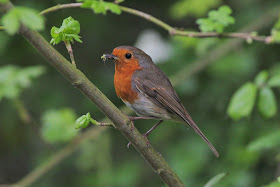nightjar anyone, and I don't mean a pint down the pub after work...
Now I'd say this is pushing it a little for Ely10, but seems to me the line of radius falls right on where we were (depending on how much you zoom the map!!). Anyway Mark, Bruce and I went to Thetford Forrest looking for nightjars. Did we see one, well, eh, not exactly...
We set off from Ely at 5.45pm with a ominous thick grey sky which shortly after opened up to what seemed like the type of rain that lasts for days... The weather had been appauling all day. The brief respite from the rain in the early afternoon was just that: brief. Our hopes were not high. In fact if we hadn't been meeting someone we quite likely would have stayed home.
We arrived though in good time and the rain had stopped and the sky cleared with a little sun poking though. Was our luck changing? We got out of the car and walked along one of the tracks. There were yellowhammer everywhere. A garden warbler sang in the scrub. We continued walking along a denser area whilst being serenaded by gold crest. Mark had intimated that he hoped to see wood lark and tree pipit. Well our luck must have changed as there were both in an area recently cleared and replanted with douglas fir. Most conspicuous was a yellowhammer resplendant on an old tree stump with a shaft on sunlight highlighting it beautiful lemony tones.
We continued with our tour (moving to the next area in the car!) and then the heavens opened, hail, thunder and torrential rain. Well we imagined we had no chance whatsoever of seeing anything else. Finally the storm passed overhead and around 9 we returned to the recently cleared area. The sun had gone down, the storm clouds passed by, this left us in a cold, misty pasture. A woodcock flew over giving us great views. Then as the light faded a raptor, big, bulky winged, with a long tail (goshawk?) flew over.
Well we pretty much gave up on the hopes of seeing or even hearing a nightjar so we decided we'd walk a couple hundred meters to an area with 5yr old trees instead of the open pasture, then go home. The air was cold and misty, no insects were out flying and no bats could be seen. We commented on how likely the earlier hail and rain would keep everything down.
We waited a few minutes then decided to get the car. I went for the car and on my way saw 3 moths flying, hmm maybe things were stirring. I brought up the car and stopped where I'd left the others. I switched of the engine and in that moment heard the most wonderful sound. Not 50m away in the top of a tree we heard a nightjar's churring song. Unfortunately this was only 1 minute long with a pause, but definitely unmistakable. Bruce who had wondered off quickly returned to the spot having heard it from couple hundred meters away.
http://www.xeno-canto.org/177518
We got into the car happy and decided to return home. On the way we decided to take a quick diversion to Queen Adelaide to see if we could hear the gropper. Hey presto. We stopped facing the factory bridge and walked down the banks of the pits. We could hear one stright away and stayed for a few minutes listening (between the rush of cars).
http://www.xeno-canto.org/178232

.jpg)

.jpg)














.jpg)
.jpg)

.jpg)
.jpg)